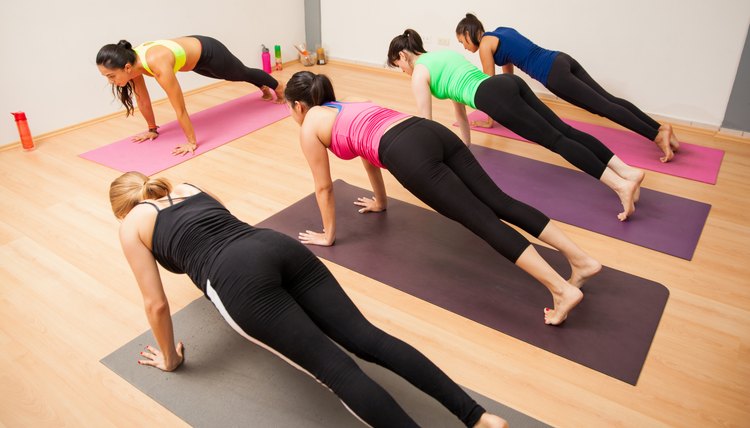What does fact checked mean?
At SportsRec, we strive to deliver objective content that is accurate and up-to-date. Our team periodically reviews articles in order to ensure content quality. The sources cited below consist of evidence from peer-reviewed journals, prominent medical organizations, academic associations, and government data.
The information contained on this site is for informational purposes only, and should not be used as a substitute for the advice of a professional health care provider. Please check with the appropriate physician regarding health questions and concerns. Although we strive to deliver accurate and up-to-date information, no guarantee to that effect is made.
Plank Exercises & Arm Pain

The plank is an exercise that is often featured in yoga, Pilates, core conditioning and functional training workouts. It can be performed from either a prone or a side-lying position, with arms either flexed or extended. In some cases, one leg is lifted from the ground. Its positioning, however, can often put an enormous amount of stress on the wrists and shoulders, which then gets referred to the arm muscles.
Deep Abs, Straight Back
The plank was designed as a core exercise, which means that it works the deeper layer of abdominal muscles. The core muscles support your internal organs. Unlike your superficial abdominal muscles, such as the rectus abdominus, they do not play an active role in spinal flexion. They do, however, support postural alignment when your spine is in an upright position. As such, the plank is performed with an elongated spine, without any flexion. Maintaining a straight back is crucial to the efficiency of the exercise.
Core Considerations
The plank may be a core exercise, but it does require you to support some of your body weight on the arms, shoulders or wrists. This often creates problems. Fitness instructors advise participants to hold the plank for about one minute or more. Participants may have sufficient core strength, but limited upper body muscular endurance. Poor postural alignment is another issue. Tight shoulders, for example will cause the shoulders to hike up toward the ears. This will change the alignment of the entire exercise, by shifting support from the core to the arm muscles.
Wrist Pain Warnings
Wrist problems are another source of referred arm pain while performing the plank. In fact, wrist conditions such as carpal tunnel syndrome may make it impossible to perform. Extended time in the position can exacerbate nerve damage to the wrist. The pain may be referred to the entire arm.
Misconceptions and Modifications
Arm pain during the plank exercise is often a sign that your form is incorrect, or that you have muscle imbalances that limit your ability to perform the exercise. Continuing to perform the plank while experiencing arm pain will not improve the situation. You need to modify the exercise, and perform specific exercises to improve alignment and strengthen your upper body.
Variations Solution
One solution is to use some easy variations of the plank exercise. You can support your weight on your forearms, as opposed to your wrists. Instead of performing the plank with both legs extended, one knee can remain on the floor. A reverse plank is performed with a foam roller. This variation requires advanced core strength, but it does not use the arm muscles. The exercise begins in a supine position, with the roller under the middle back. The arms are crossed across the chest, and the core muscles are used to lift the hips off the ground into a reverse plank position.
References
Writer Bio
In 1999, Lisa Mercer’s fitness, travel and skiing expertise inspired a writing career. Her books include "Open Your Heart with Winter Fitness" and "101 Women's Fitness Tips." Her articles have appeared in "Aspen Magazine," "HerSports," "32 Degrees," "Pregnancy Magazine" and "Wired." Mercer has a Bachelor of Arts in psychology from the City College of New York.
